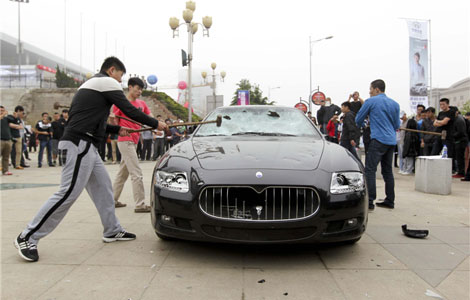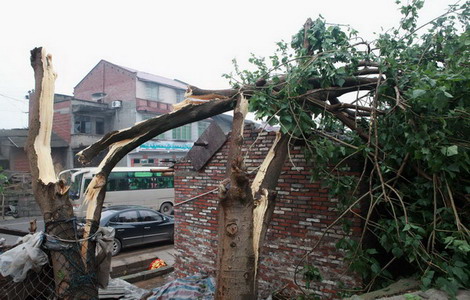
Imagine your office and bedroom installed with smart controls, raising and lowering window blinds according to the sun’s movement. Lights in a vacant room will switch off automatically in five minutes. The use of energy is carefully monitored. A ball-like petsitter device helps feed and play with your beloved animals while you are away.
Smart robots patrol the neighborhood. Footpaths, cycling trails and green transport are planned around the city. In case of an emergency, a smart response system helps divert traffic and direct drivers to the quickest route leading to the nearest hospital.
“It’s a grand plan, but it’s also a necessity,” says Terence Yap, chief executive officer of Smart China, a solution provider for “smart cities” — almost a fledgling concept in the country.
Speaking from his brand-new office at Hong Kong Science Park, which enjoys a panoramic 180-degree harbor view, Yap energetically reveals a plan that has wowed many investors.
“We expect our revenue to surpass the $1 billion mark this year, and hopefully, by 2017 reach $10 billion,” he says of Smart China, the subsidiary of a global security company, established in 2011.
To Yap, this is far from ambitious, given the rosy prospects of smart cities on the Chinese mainland.
“If you look at it, it’s still small — less than 1 percent compared to the whole (Chinese) market, which means a future market opportunity,” he tells China Daily Asia Weekly. “By 2020, we want to be the leading provider (of smart city development).”
This target is in line with that of some developing countries including China to reduce carbon emission.
The concept of the “smart city” is not entirely new to China. But its close relatives such as the “digital city”, “l(fā)ow-carbon city”, or “green city” cover only a part of the larger concept.
Most experts agree that smart cities are a more holistic approach. A city is regarded as “smart” when investments yield sustainable economic development and quality of life, accompanied by effective management of environment and natural resources.
The government has picked 90 cities and counties as pilots. Examples are Beijing’s Chaoyang district and Shanghai’s Pudong New Area. Another batch of 50 cities will be announced later this year.
“Bear in mind, we are only talking about 140 cities. How many cities does China have? We are not even talking about the rest of Asia,” Yap says.
Beijing has aimed high in the 12th Five-Year Plan (2011-2015): Green buildings will account for 20 percent of all the ones in China by 2015. Energy consumption per unit of GDP will be lowered by 16 percent and carbon dioxide emissions by 17 percent.
Funds are not an issue. The China Development Bank has announced it would lend as much as 80 billion yuan ($12.7 billion) for smart city projects until 2015. These projects are expected to drive 1.1 trillion yuan investment, with early-stage investment in infrastructures worth 500 billion yuan.
China already has green-concept development around specific themes, from wind and solar hubs to eco-industrial parks boasting a clean transport system. But Yap remains skeptical about piecemeal approaches.
“You’re not smart but one part of it,” he says. “You see ad hoc developments going on in cities such as Shenzhen, Beijing and Tianjin. I don’t think there is one city we can really call ‘smart’ yet.”
The Tianjin eco-city, a Sino-Singaporean partnership, is the most successful project to date, but it will operate fully only from 2020.
Benny Chow, director of sustainability with Aedas Architects, tells China Daily that most provinces are building a demonstration “eco-city”.
“(These projects) all have wonderful master plans,” says Chow. “But in terms of implementation, there are still lots of obstacles because they involve large pieces of land.”
Some early model cities began with grand visions but failed to get off the ground. Dongtan, an eco-city designed for a population of 500,000 on Chongming Island in Shanghai, has been delayed. Only a wind turbine farm was built — with neither buildings nor infrastructure around.
Some experts say smart cities should start small. High costs are incurred to demolish and repurpose existing infrastructure in legacy cities.
“Drawing on a piece of white paper is the easiest,” Yap says.
The urbanization rate in China reached 51 percent in 2011, up from just 18 percent 30 years ago. For the first time there are more people living in Chinese cities than in rural areas.
Moreover, in the next 15 years, some 200 million are expected to migrate from the countryside to urban areas, according to the National Bureau of Statistics.
Urbanization has been a key area of interest for policymakers since the Communist Party of China’s 18th National Congress in November.
“Unlike the West, this rate of urbanization is unprecedented. Large-scale city building is necessary for China,” says Pan Yunhe, executive vice-president of the Chinese Academy of Engineering.
While some developers and town planners are impatient with their plans, Pan raises objections: “Thirty years later, is our next generation going to demolish the city we build today?
“How many cities we build today can still stand as top-notch cities such as London and Paris in the next decade?” he asked, speaking at the First International Forum on Smart Cities and Systems held in Hong Kong in March.
Adding to this context is China’s economic slowdown.
“For the first time in 30 years, China is no longer seeing a double-digit growth. Production surplus paves the way for economic restructuring. What the country needs is a new boost to the economy,” says Cao Guohui, chief strategy officer with China Security and Surveillance Technology, parent company of Smart China.
A “third industrial revolution” is underway, says Cao, thanks to the country’s rising demand for Internet technology and renewable energy.
However, while smart cities are a neat solution to challenges facing the Chinese economy, from environmental degradation fueled by runaway urbanization to the pressing need to push forward industrialization and informatization, the road to them is far from smooth.
“The hardware is there, but how do we integrate people (with the city)?” Yap with Smart China says. “New migrants are moving into these cities every day. How do you educate them? How do you build a culture around it?
“It’s not as simple as bringing in people. You got to teach them how to use it and change the way of living — adopting it, applying it. This is part of a smart city.”
Creating a sense of adhesion is key. “Cities are (built for) people after all,” Yap adds.
The absence of a well-defined regulatory framework too remains an issue. Unlike green buildings which are certified by the country’s three-star rating system, there is no official certification for smart cities yet.
This raises a question about the smart city label being used as a marketing and sales tool by property developers.
“There’s the danger … ‘Smart’ is not a product (itself),” says Yap, who foresees China coming up with its own certification system in the near future. “We are not building a system that is a dream; we are building a system that is required.”







